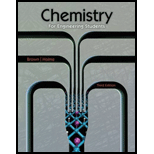
Interpretation: The mechanism by which chemistry and engineering helped transform aluminum from a precious metal into an inexpensive structural material should be explained.
Concept Introduction:
Aluminum is known to be the world’s most abundant metal. It is the third most common element and present as the 8% of the earth’s crust. It is derived from the mineral bauxite.
Pure form of aluminum is soft, corrosion resistant, ductile and has a high electrical conductivity. It is used as foil and conductor cables by alloying with other metals in order to give strength to it. It is known to be the lightest engineering metal with strength to weight ratio. More than the steel, this makes aluminum an important structural material. Opposite to steel, the strength of aluminum increases on decreasing temperature. Thus, aluminum works well in the cold atmosphere. For pure aluminum, the tensile strength is 90 MPa which is increased to 680 MPa for the aluminum alloys treated with heat.
Explanation of Solution
The increase in application of the aluminum is due to its properties such as strength, recyclability, lightness, formability and resistance to corrosion. The types of product ranges from the packaging foils to the structural materials.
Aluminum is generally alloyed with metals such as magnesium, zinc, copper, manganese, silicon, and lithium. Other metals such as titanium, chromium, lead, nickel and bismuth are also added in small quantities.
The tensile strength of pure aluminum is low, after the addition of other metals for alloying, the strength of the aluminum increases.
Mechanisms for strengthening aluminum:
The engineering applications commonly for aluminum includes automotive, aerospace, buildings, beer and soda cans. Since, the pure aluminum is soft, the strengthening of aluminum is important to use it for engineering structures.
The strength of aluminum is modified with the help of the cold working, heat treating and alloying. Generally, the strength of alloys can be increased by cold working but some of the alloys required additional strength and undergoes solid solution strengthening, precipitation strengthening, and dispersion strengthening.
Cold working: This reduces the material thickness. The sheets and plates of different thickness are made with the help of cold rolling. Generally, the strength of all the aluminum alloy can be increased by cold working.
Solid solution strengthening: The strength of metal increases when any alloying element is added to the aluminum. The mixture so formed is called a solid solution as the aluminum is mixed with the alloying atoms. The strengthening extent depends on the type and percentage of alloying elements added to the aluminum.
Precipitation strengthening: The particles with size less than 0.001 mm are formed inside the metal in this process. The particles are known as precipitates and contain the aluminum compounds with alloying elements or alloying elements compounds. This is due to the series of heat treatment. When the precipitate is formed, the step is known as aging.
Dispersion strengthening: In the aluminum casting process, when alloy of manganese reacts with aluminum and silicon and iron, the dispersoid particles are formed. The diameter of these particles is less than 0.001 mm. The grain structure is influenced by the dispersoid particles which is formed during the heat treatment. This results in the increase strength of alloy as compared to the one formed without dispersoids.
Want to see more full solutions like this?
Chapter 1 Solutions
Chemistry for Engineering Students
- Define the bonding that exists in metals and how this model explains some of the unique physical properties of metals. What are metal alloys? Identify the two main types of alloys, and describe how their structures differ. Give several examples of each type of alloy.arrow_forwardDescribe how ultrapure silicon can be produced from sand.arrow_forward
 Chemistry for Engineering StudentsChemistryISBN:9781285199023Author:Lawrence S. Brown, Tom HolmePublisher:Cengage Learning
Chemistry for Engineering StudentsChemistryISBN:9781285199023Author:Lawrence S. Brown, Tom HolmePublisher:Cengage Learning Chemistry: The Molecular ScienceChemistryISBN:9781285199047Author:John W. Moore, Conrad L. StanitskiPublisher:Cengage Learning
Chemistry: The Molecular ScienceChemistryISBN:9781285199047Author:John W. Moore, Conrad L. StanitskiPublisher:Cengage Learning Introductory Chemistry: A FoundationChemistryISBN:9781337399425Author:Steven S. Zumdahl, Donald J. DeCostePublisher:Cengage Learning
Introductory Chemistry: A FoundationChemistryISBN:9781337399425Author:Steven S. Zumdahl, Donald J. DeCostePublisher:Cengage Learning General Chemistry - Standalone book (MindTap Cour...ChemistryISBN:9781305580343Author:Steven D. Gammon, Ebbing, Darrell Ebbing, Steven D., Darrell; Gammon, Darrell Ebbing; Steven D. Gammon, Darrell D.; Gammon, Ebbing; Steven D. Gammon; DarrellPublisher:Cengage Learning
General Chemistry - Standalone book (MindTap Cour...ChemistryISBN:9781305580343Author:Steven D. Gammon, Ebbing, Darrell Ebbing, Steven D., Darrell; Gammon, Darrell Ebbing; Steven D. Gammon, Darrell D.; Gammon, Ebbing; Steven D. Gammon; DarrellPublisher:Cengage Learning Chemistry: Principles and PracticeChemistryISBN:9780534420123Author:Daniel L. Reger, Scott R. Goode, David W. Ball, Edward MercerPublisher:Cengage Learning
Chemistry: Principles and PracticeChemistryISBN:9780534420123Author:Daniel L. Reger, Scott R. Goode, David W. Ball, Edward MercerPublisher:Cengage Learning Chemistry & Chemical ReactivityChemistryISBN:9781133949640Author:John C. Kotz, Paul M. Treichel, John Townsend, David TreichelPublisher:Cengage Learning
Chemistry & Chemical ReactivityChemistryISBN:9781133949640Author:John C. Kotz, Paul M. Treichel, John Townsend, David TreichelPublisher:Cengage Learning





